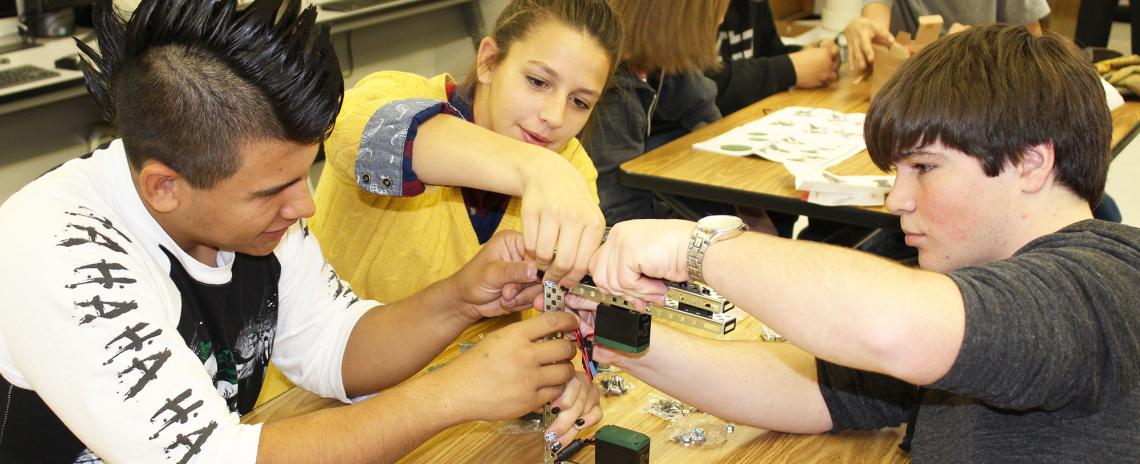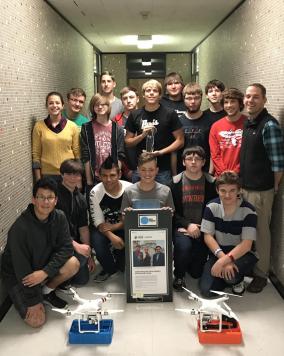From Panhandle to Spotlight: An electronics class, their drones, and national acclaim
From Panhandle to Spotlight: An electronics class, their drones, and national acclaim
By Tyler Dahlgren
The Journey
The idea was simple, really.
Instead of showering entire fields of crops with pesticides and herbicides, what if a drone could be used to detect the precise location of weeds? The ability to target specific portions of a crop would eliminate the need to blanket spray a field.
The ensuing journey, which started with a submission into Samsung’s Solve for Tomorrow Contest, was anything but simple for Justin Reinmuth and his 19 Gering High School electronics students. More like the ride of a lifetime.
“We came across the Samsung Solve for Tomorrow contest, read the details, and a girl in our class made a simple observation about something she saw her dad doing,” Reinmuth said. “He was spraying the cracks with weeds in the driveway rather than spraying the entire driveway. Why do we spray entire fields?”
Through collaboration with one another, the Gering community and the University of Nebraska at Lincoln Extension Program, Reinmuth’s group was able to construct a working prototype the day before their project video was due.
It was a great concept, and Reinmuth was proud of his kids for working together to produce a fine end product. Winning the contest wasn’t exactly the most pressing thing on his radar.
Then came the whirlwind.
First, Gering was selected as a state finalist. Then, a national finalist. Was this really happening?
“When we were chosen as one of the 10 finalists to go to nationals in Washington D.C., I was kind of dumbfounded,” said Reinmuth, who pulled three students’ names out of a hat to determine Gering’s representatives in the nation’s capital.
The small group of Bulldogs headed east, representing their Panhandle community, and the state of Nebraska. They traded in views of Chimney Rock for the Washington Monument, excited, and a little nervous, for the chance to show off their drones.
“You’re being judged, so it’s a feeling of having these five people judging you on how you do through the presentation and how you describe your project,” said senior Payton Welfl. “I was nervous out of my mind. I didn’t want to go up there. We just had to face it and go do it.”
Okay, maybe more than a little nervous. It’s not often that a few kids from Western Nebraska find themselves on the center stage in one of the country’s premiere STEM (Science, Technology, Electronics and Mathematics) competitions.
“You have these major schools from downtown New York and Chicago and Texas,” Reinmuth said. “They didn’t announce the winner. Instead, everyone looked up at the big screen, where the submission videos would indicate the winners.”
Just as the butterflies started fluttering, a familiar clip rolled on the big screen.
So much for suspense. There had been enough of that.
“Ours was the very first to be played,” Reinmuth said. “The kids were crying, and we had to go up and accept it. It was an extreme honor. It’s a once-in-a-lifetime experience for a teacher.”
A once-in-a-lifetime experience for a teacher that, coincidentally, has made being a part of the STEM program in Gering an incredible experience for students.
The Reward
These days, Justin Reinmuth’s class looks more like the sales floor of a futuristic Best Buy than a high school science room, thanks to their grand prize of $150,000 of Samsung technology.
In between building robots, a trio of Intro to Engineering (a new class developed to utilize the school’s new toys) students took time on a Monday morning to talk about their new tech.
“A lot of it is stuff you’ve heard about, but you’re like ‘That is really expensive stuff that we don’t have’,” said junior Matthew Eckerberg. “We have 3D printers now and these really nice computer monitors that are like 27 inches with curved screens and each computer has its own set of soundproof Bluetooth headphones. We have super beefed up computers now, too.”
Interest in the class, which started as Electronics, skyrocketed. Before the Samsung Solve for Tomorrow Contest, Gering would struggle to get enough kids to sign up to offer the class. Eight one year. Nine the next. Ten if they were lucky.
“Now we have two sections of 24, and some kids couldn’t get into the class,” said GHS principal Eldon Hubbard. “When we complete the renovation to the high school, we are going to have a better, more expansive classroom for them to work in.”
The fancy new equipment has something to do with the surge in interest, as did the move from a shop to the main building, but Hubbard said Reinmuth’s approach to instruction, which provides hands-on learning opportunities, is the main reason 50 kids are itching to get in.
“Kids love to get in there, build something, and see if it’s going to break,” Hubbard said. “That instructional model is very enticing to kids, and the reason we’ve gone from a dozen to 50 students that want to take the class.”
It’s helping students not only in the present, but by setting them up for the future.
“I plan to attend South Dakota School of Mines to pursue mechanical engineering,
said senior Adam Moench. “With this class becoming more of an intro to engineering as opposed to just electronics, it has given me a bigger step towards getting my feet wet in what I’ll be doing next year.”
As a sophomore, Rachel Rawlings wasn’t even aware that electronics was offered at the school. Her interest peaked as the school found itself in the national spotlight.
“I’ve always been interested in engineering, and it was exciting to have it available,” Rawlings said. “I’ve learned a lot. It’s really cool and I think that I’ll definitely go into something STEM related in the future.”
Welfl adds that his school has top notch welding and auto programs.
“I’ve taken advantage of them and I get more out of what I want to do for my career by going to school in Gering,” he said.
STEM is an area that will continue to be explored, too. It’s ever-evolving, so the opportunities it provides are too.
“For girls in STEM programs, it’s almost a 100 percent hiring rate when they get out of it,” Reinmuth points out. “It is definitely preparing kids for careers that might not even be invented when they start college, but that will be there when they get out.”
In late September, USA Today featured a full-page congratulations honoring Gering’s accomplishment. Three Gering students-Welfl, Lexi Johnson and Eric Crane proudly showing off a project that would change their school forever.
The caption said it all.
“Celebrating the future leaders of tomorrow, today.”
The Teacher
Things haven’t really slowed down for Reinmuth and Co.
With all the new gadgetry, there’s much to explore. Samsung encouraged the school to enter the contest again this year. There’s no limit or repeat-winner restrictions. Only possibilities.
The class is focused in on developing a three-stage gravity-fed filter system that would cease the shedding of plastic into the water system that occurs when clothes are washed.
“We are going to give it a shot and see what happens,” Reinmuth said. “November 11th is the closing date, and we should know around Thanksgiving if we’ve made it to the state level. We’re hoping to do the best that we can.”
Reinmuth doesn’t have a PhD in STEM, he jokes, but he does have a propensity to challenge his students. Getting 19 high schoolers to work together cohesively takes a knack for facilitation.
“There were a lot of disagreements,” Welfl admits. “We all had our own ideas. A teacher like Mr. Reinmuth helped us find a way to make it all work.”
At the outset, Reinmuth could sense his students were becoming frustrated. Over time, students started using their particular strengths whenever they’d run into a dead end.
“It was unique to see how, after a while, they understood that they all had to use their own strengths and utilize what they brought to the team,” Reinmuth said. “To have an entire class based on projects was something I had to learn myself. When I went to college to be a teacher, that’s not the first thing they teach you. It’s more lesson plan stuff.”
Reinmuth, a Gering graduate, and his students are learning as they go.
“Some of it is trial and error, some of it is reading, and some of it is jumping on the shoulders of giants, as they say, looking at what other people have done throughout the country,” he said.
National acclaim, STEM conventions and full page features in the USA Today.
“All in all, it was a wonderful ride,” Reinmuth said. “Our room is now fully equipped with about anything you could ask for when it comes to modern engineering.”
The class huddles together for a picture, their two drones all the way in front with the Samsung award in the middle. They get situated, and smile proudly.
Then it’s back to work.
Those robots aren’t going to build themselves.
In addition to Welfl, Johnson and Crane, 16 other Gering electronics students participated in the drone project. They are Jonathan Blanco, Dakota Boles, Blake Brunner, Jeremy Forella, Xavier Horst, Trevor Satur, Carson Wallace, Skylier Ward, Joshua Wilson, Curtis Anderson, Gabriele Castro, Cody Catron, Michael Haworth, Kaiden Reinmuth, Tyler Smith, and Joel Torres.



